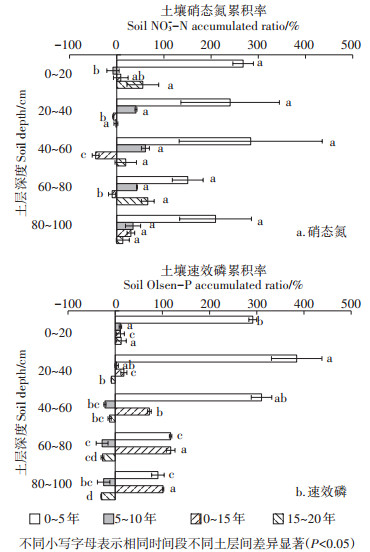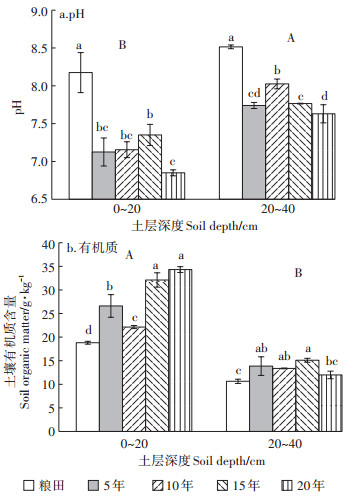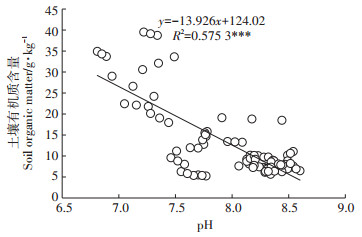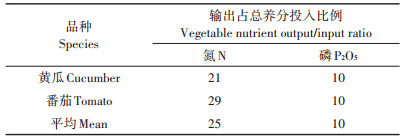2. 农业农村部黄淮海平原农业环境重点实验室, 济南 250100;
3. 山东省农业面源污染防控重点实验室, 济南 250100
2. Key Laboratory of AgroEnvironment of Huang-Huai-Hai Plain, Ministry of Agriculture and Rural Affairs, Jinan 250100, China;
3. Shandong Provincial Key Laboratory of Agricultural Non-Point Source Pollution Control and Prevention, Jinan 250100, China
设施蔬菜合理施用肥料是获得高产高质蔬菜、维持土壤地力和减少过量氮磷引起环境污染的关键。早在2000年的调研发现,山东省蔬菜大棚由于过量施用化肥,已经出现了严重的养分累积,P2O5的累积量在4000 kg·hm-2以上,N和K2O的含量也在1500 kg·hm-2以上[1]。2006年,山东寿光设施菜田表层土壤硝态氮的含量是露地土壤的6.5倍,氮淋溶深度已经达到土壤5~6 m处,对地下水构成了严重威胁[2]。2016年我国设施蔬菜面积已经高达5872万hm2,是世界第一,并且还以每年10%的速度在增长。而农民为了追求高产,不惜大量投入化肥和有机肥,这种高水、肥投入的管理模式给土壤以及地下水环境带来了巨大的风险[3]。蔬菜作物对养分需求虽然较高,但实际生产中,农民在施用化肥的基础上会投入有机肥以期提升土壤质量保证作物品质,但是却忽略了有机肥中含有大量有效养分,导致养分投入量远超作物需求[3-4]。据调查,有机肥提供的氮养分会占到总施氮量的一半以上,并且以畜禽粪便为主[5],容易造成土壤酸化、盐碱化,地下水污染。连续5年施用沼肥导致0~180 cm土层土壤中磷素盈余随着沼肥使用比例的增加而显著增加,从而增加了菜田土壤磷素累积和淋失的风险[6]。土壤硝态氮含量变化在作物不同生育阶段具有一定规律性,且在0~60 cm土层中的变化最为明显[7]。山东是设施蔬菜产业的发源地,常年过量施肥导致的土壤质量下降、养分流失等环境问题逐渐成为蔬菜清洁生产、生态发展的瓶颈,设施菜田土壤养分含量分布特征如何,也是未来设施蔬菜生产体系进一步优化施肥的关键。
本研究于2016年在山东省全省范围内开展了设施蔬菜黄瓜和番茄施肥情况的调查,同时选取不同种植年限的设施大棚,采集土样进行养分测定分析,揭示目前山东设施菜田养分施用情况以及土壤氮磷养分累积和迁移变化的特征,为未来设施蔬菜绿色清洁生产提供数据支撑。
1 材料与方法 1.1 调查方法及内容本研究采用农户抽样调查的方法,对山东省2015—2016年设施黄瓜和番茄的种植农户进行了实地调查。根据设施蔬菜种植面积和生产水平的高低,结合地理位置,在山东省抽取3个县(市、区),分别是胶州市、寿光市和东阿市。抽样调查采用概率抽样抽取样本,在每个县(市、区)随机抽取2个乡镇,每个乡镇随机抽取2个村,每个村按户主名册等距抽取20户。各县(市、区)的被调查农户在地理位置、产量和管理水平等方面均具有代表性。实际调查户数为207户,设施大棚种植模式主要有2种:冬春茬种植黄瓜(n=59)或者番茄(n=27),秋茬种植黄瓜(n=79)和番茄(n=42)。调查内容主要包括肥料种类、肥料养分含量、施肥量、大棚面积蔬菜产量等指标。农户施用的氮、磷、钾肥养分含量的计算:化肥采用包装袋上标识的量;有机肥养分含量采用文献《中国有机肥料养分志》提供的数值计算[8-9]。单位面积大棚一年内使用的化肥和有机肥的质量乘以各自养分含量,再相加后得出肥料年施用折纯量。黄瓜和番茄所需养分比例数据采用文献[10-11]计算。
1.2 试验分析 1.2.1 土壤样品采集山东省淄博市临淄区淄博东科蔬菜专业合作社自2012年被山东省土壤肥料总站任命为“山东设施蔬菜测土配方施肥”推广的试点企业之一,其施肥管理模式在山东省具有很强的代表性。该社大棚统一采用有机肥和化肥配施的施肥方案,有机肥主要采用干鸭粪和牛粪,本研究选择了施用鸭粪的4个不同种植年限的大棚,分别为5、10、15年和20年,同时选择大棚周边的粮田(小麦)土壤(褐土)作为对照。种植作物为西葫芦-番茄轮作,土壤为褐土,每个大棚取5钻土壤制备混合样,按照20 cm一层分别采集0~100 cm的土壤。取样时间为2017年5月25日,设施中前季冬春茬西葫芦刚收获。所有大棚统一使用膜下滴灌灌水方式。
1.2.2 测定方法采集的鲜土用2 mol·L-1 KCl溶液(土水比1:5)浸提,并通过氮素连续流动分析仪(TRAACS 2000,Bran and Luebbe,Norderstedt,Germany)测定硝态氮;土壤有机质采用重铬酸钾-浓硫酸氧化(外加热法),硫酸亚铁溶液滴定法测定;速效磷采用0.5 mol·L-1碳酸氢钠浸提-钼锑抗比色法测定;速效钾采用1 mol·L-1乙酸铵浸提-火焰光度计测定。
1.3 统计及分析方法数据采用SPSS 20.0进行方差分析,多重比较采用Duncan分析,显著性差异水平为0.05。采用Excel和Sigmaplot 12.5进行数据处理和绘图。
2 结果与分析 2.1 山东省设施菜田养分投入量在养分投入中,有机肥作为基肥一次性投入,从图 1中结果可见,黄瓜、番茄的有机肥和无机肥氮、磷、钾投入量相当。黄瓜氮、磷、钾的总投入量分别为1033、765 kg·hm-2和1068 kg·hm-2,番茄分别为710、503 kg·hm-2和755 kg·hm-2,番茄中养分总投入量略低于黄瓜。

|
图中虚线表示平均值 The dotted line in the figure indicates the mean value 图 1 黄瓜和番茄的无机肥和有机肥养分投入量 Figure 1 The nutrient input from chemical fertilizer and organic fertilizer for cucumber and tomato |
在临淄选取的设施西葫芦养分投入见表 1,氮、磷、钾养分总投入量分别是1065、1020 kg·hm-2和1395 kg·hm-2。氮总养分投入量和调查结果相当,磷的总投入量高出调查结果的37%~50%,钾的总投入量高出26%~48%。其中有机肥氮、磷的投入分别是化肥投入的2倍和5倍,化肥氮、磷的投入大幅减少。
|
|
表 1 设施西葫芦养分投入量 Table 1 The nutrient input for marrow |
调查的设施菜田秋茬种植的时间较短,平均3~4个月,冬春茬蔬菜生长期长,平均6~7个月。不同设施菜田蔬菜产量差异明显,黄瓜平均产量为66 t·hm-2(CV%=55.68),番茄平均为57 t·hm-2(CV%=52),黄瓜和番茄均根据吸收参数计算其养分吸收量。从表 2中可见,黄瓜和番茄氮、磷养分输出占总投入比例较低,分别为25%和10%。
|
|
表 2 黄瓜和番茄的氮、磷输出占总养分投入量的比例(%) Table 2 The vegetable nutrient output/input ratios for cucumber and tomato (%) |
种植5年和10年的设施西葫芦产量分别为317 t·hm-2和312 t·hm-2,15年和20年的设施西葫芦产量分别为224 t·hm-2和222 t·hm-2,显著低于种植年限较短的菜田(表 3)。从果实养分输出比例来看,5年和10年设施菜田氮输出占养分投入的比例达到了59%以上,磷输出比例均在18%以上,而15年和20年设施菜田氮输出比例均为42%,磷为13%,均低于较短年限菜田养分输出(表 3)。
|
|
表 3 不同年限设施大棚产量和果实氮、磷输出比例 Table 3 The greenhouse vegetable yields and the fruit nutrient output/input ratios as affected by different cultivation years |
由图 2a可知,粮田土壤0~100 cm不同土层中的硝态氮含量相当,平均为3.5 mg·kg-1,设施菜田不同土层中硝态氮含量均显著高于粮田土壤。在整个0~ 100 cm土层中,设施菜田硝态氮含量在0~20 cm含量较高,平均为15.85 mg·kg-1,其次是60~80 cm和80~ 100 cm,硝态氮平均含量分别为13 mg·kg-1和16 mg· kg-1,20~60 cm土壤中硝态氮含量较低,平均为11 mg·kg-1。说明硝态氮在土层中发生了迁移。除40~ 60 cm土层外,其余土层中土壤硝态氮含量随着设施菜田种植年限的增加而增加,尤其在80~100 cm深层土壤中更明显,种植5年的硝态氮含量和粮田土壤没有显著差异,而20年和15年设施菜田中硝态氮含量显著高于10年和5年的菜田土壤。

|
不同小写字母表示同一土层不同年限间的差异显著,大写字母表示所有年限不同土层间的差异显著(P < 0.05) The different lowercase letters indicate the significant differences among the different cultivation years of greenhouse vegetables in the same soil depth, the uppercase letters indicate significant differences among the different soil depths (P < 0.05) 图 2 不同年限设施菜田土壤硝态氮和速效磷在土层中的累积量 Figure 2 The accumulation of soil nitrate-N, soil Olsen-P in 0~100 cm soil depths with different cultivation years of greenhouse vegetables |
由图 2b可知,设施菜田土壤速效磷含量在0~ 100 cm土层中均显著高于粮田土壤,菜田土壤速效磷在0~20 cm和20~40 cm中大量累积,显著高于深层土壤,并且随着种植年限的增加而增加。在0~20 cm土层中种植20年的设施菜田的速效磷含量达到345 mg·kg-1,较周围粮田土壤提高436%,相较于5年的设施菜田土壤提高37%,在20~40 cm土层中速效磷平均含量达到190 mg·kg-1。随着土层的加深土壤速效磷含量逐渐降低,在80~100 cm土层中平均达到57.68 mg·kg-1。在20~100 cm土层中,15年设施菜田的速效磷含量显著高于其他种植年限的菜田。
2.4 设施菜田不同土层氮、磷含量的累积速率随着年限的延长,土层中硝态氮和速效磷在不同种植时间段中的累积速率也存在差异(图 3)。由图 3a可知,种植5年的设施菜田和粮田土壤相比,0~100 cm土层中硝态氮均处于累积状态,土层之间没有差异,平均累积速率为238%;5~10年的累积率在0~ 20 cm为负值,20~100 cm为正值,说明在表层硝态氮以向下层迁移为主,深层土壤仍然呈累积状态,且不同土层间累积速率没有显著差异;10~15年间,硝态氮向下迁移主要发生在40~60 cm,且显著高于20~40 cm和60~80 cm。15~20年间硝态氮在不同土层中又呈现累积状态。

|
不同小写字母表示相同时间段不同土层间差异显著(P < 0.05) The different lowercase letters indicate the significant differences among the different soil depths in the same period(P < 0.05) 图 3 不同年限段设施菜田土壤硝态氮和速效磷在0~100 cm土层中的累积率变化 Figure 3 The accumulation ratios of soil nitrate-N, soil olsen-P in 0~100 cm soil depths with indifferent cultivation years of greenhouse vegetables |
由图 3b可知,土壤速效磷在0~5年间主要呈累积状态,0~60 cm中的累积速率显著高于深层60~100 cm;5~10年间速效磷在40~100 cm土层中累积速率为负值,说明以向下迁移为主;在10~15年间,速效磷在0~100 cm土层中的累积速率都是正值,深层60~ 80 cm和80~100 cm的累积速率显著高于其他土层;15~20年间,20~100 cm中速效磷的累积速率都是负值,且60~80 cm和80~100 cm显著低于浅层土壤,说明在15~20年间土壤速效磷在深层土壤中的累积含量过高,并发生了严重的迁移。
2.5 不同年限设施菜田土壤pH和有机质含量变化由图 4a可知,和粮田土壤相比,设施菜田0~20 cm和20~40 cm土壤pH值均显著降低,并且随着种植年限的延长,降低的幅度增大。20年设施菜田0~20 cm土壤pH值仅为6.85,比粮田土壤降低1.33个单位,即使只种植了5年的设施菜田,pH值也降低1.05个单位。在20~40 cm的根层土壤中,粮田土壤pH值为8.52,不同年限设施菜田土壤pH降低幅度为0.49~ 0.89个单位,平均为0.73个单位。

|
不同小写字母表示同一土层不同年限间的差异显著,不同大写字母表示所有年限不同土层间的差异显著(P < 0.05) The different lowercase letters indicate the significant differences among the different cultivation years of greenhouse vegetables at the same soil depth, the uppercase letters indicate significant differences among the different soil depths (P < 0.05) 图 4 不同年限设施菜田土壤pH值和土壤有机质含量 Figure 4 The soil pH and organic matter contents in 0~40 cm soil depths with different cultivation years of greenhouse vegetables |
由图 4b可知,土壤有机质主要集中在表层0~20 cm土层中,设施菜田土壤有机质含量均显著高于粮田土壤,且随着种植年限的增加不断增加,但在10年种植年限的设施菜田表层土壤有机质含量却有降低。土壤中有机质的矿化分解取决于土壤中微生物的作用,根据土壤微生物对外源有机质矿化能力的反映而产生的正负激发效应,将微生物分为受碳源限制的土著性微生物和受氮源限制的发酵性微生物[12]。在本试验中,10年种植年限的设施菜田表层土壤硝态氮含量较低,此时土壤有机质含量也较低,这可能是因为土壤微生物活性数量以及其群落组成发生了变化。20年设施菜田土壤0~20 cm有机质含量为34.32 g· kg-1,相对粮田土壤增加82%,比种植5年的设施菜田土壤增加29%。在20~40 cm土层中,设施菜田土壤有机质含量均减少,不同年限之间没有显著差异,平均含量为13.58 g·kg-1,相较于粮田土壤增加28%。
2.6 不同年限设施菜田土壤pH值、土壤有机质和土壤养分含量相关性设施菜田土壤pH和土壤速效磷含量呈极显著负相关,相关系数为0.935,土壤pH与土壤硝态氮含量没有显著相关关系(图 5)。从图 6可以看出,设施菜田土壤有机质含量和土壤速效磷呈极显著正相关,相关系数为0.827,和土壤硝态氮也没有显著相关性。土壤pH和土壤有机质含量呈极显著负相关,相关系数为0.758(图 7)。

|
***表示在P < 0.001水平下的显著差异 *** indicates the significant difference at the level of P < 0.001 图 5 不同年限设施菜田土壤pH与土壤硝态氮、速效磷含量的相关性 Figure 5 Correlation between soil pH and NO3--N, Olsen-P in the soil with different cultivation years of greenhouse vegetables |

|
图 6 不同年限设施菜田土壤有机质含量与土壤硝态氮、速效磷含量的相关性 Figure 6 Correlation between soil organic matter and NO3--N, Olsen-P in the soil with different cultivation years of greenhouse vegetables |

|
图 7 不同年限设施菜田土壤pH与土壤有机质含量相关性 Figure 7 Correlation between soil pH and organic matter contents in the soil with different cultivation years of greenhouse vegetables |
20世纪90年代我国蔬菜大棚肥料氮的施用量为1828 kg·hm-2,磷和钾分别为2590 kg·hm-2和730 kg· hm-2,有机肥施入的氮、磷、钾分别是659、688 kg·hm-2和442 kg·hm-2[2]。到2011年每季化肥氮的平均投入量为1169 kg·hm-2[13],和90年代相比降低36%。从对山东两种主要蔬菜的施肥情况进行调研发现,目前设施菜田的化肥投入量已经呈现下降趋势,和90年代相比,化肥氮、磷、钾的平均投入量分别减少71%、85%和16%(图 1)。设施黄瓜和番茄果实养分输出占总养分投入比例平均达到了25%(N)、10%(P2O5)和29%(K2O)(表 2),显著高于十几年前的调研结果[1],而临淄大棚合作社设施西葫芦中果实养分输出比例更高,种植5年和10年的菜田果实氮输出达到了59%以上,是调研结果的2倍多,磷输出比例也提高了0.8倍,说明近年来设施菜田养分利用率也在逐渐提高。临淄设施菜田氮肥的投入量为375 kg·hm-2,也更接近设施蔬菜的优化推荐施氮量341.7 kg·hm-2[14],但是总量仍然超过了蔬菜的实际需求(图 1、表 1),反而更易造成土壤氮磷过量累积和淋溶风险。从养分投入量与蔬菜产量的相关性发现,钾肥的用量和蔬菜产量有显著的正相关性[15],从钾肥施用不足[4]到钾肥过量,说明农户越来越重视钾肥的施用效果。
3.2 土壤酸化和养分累积加剧设施条件高温高湿,土壤有机质矿化率高于其他农业生产体系[16],有机肥的投入是补充土壤有机质非常重要的形式,是维持土壤肥力的关键[17]。从调研结果以及临淄设施大棚的化肥、有机肥投入量可以看出,化肥的投入量开始呈现下降趋势并逐渐降低到推荐施肥量的范围内[14],但是有机肥的投入量却在逐渐增加。化肥和有机肥配施会明显提高表层土壤易氧化有机质含量[16, 18],但长期施用较高水平的有机肥会造成土壤中氮、磷养分盈余量增加,进一步导致投入水平不平衡及造成面源污染的风险[19-21]。虽然施用有机肥对土壤pH变化有一定的缓冲作用[22-23],施用经过高温发酵的堆肥或者厩肥等碱度有机肥,能够有效地控制土壤酸化[24],但是施用过量、施用年限过长以及设施菜田单种类型不同品种作物的轮作(菜-菜)模式下,土壤有机肥对土壤pH的缓冲效果并不明显[25],仍然容易导致酸化。本研究也印证了这一点,土壤有机质含量和土壤pH呈显著负相关性,说明有机质的增加反而会进一步导致土壤酸化,而酸化土壤更利于速效养分的释放(图 5和图 7)。尤其磷在有机肥中的形态主要是无机磷[26],对土壤速效磷的累积贡献更大。本研究中土壤有机质含量和土壤速效磷含量呈显著正相关(图 6),20年设施菜田土壤表层土壤有机质含量相对种植5年的土壤有机质含量增幅为29%,而速效磷含量的增幅达到37%(图 2b和图 4a)。所以,应合理控制有机肥种类选择和数量投入,例如当土壤残留的养分含量过高且足以满足后茬作物对养分的需求[27-28]时,在下一茬作物种植前可以减少有机肥的施用,或者选用不同种类有机肥。
3.3 设施菜田土壤氮、磷累积与迁移的时空变化农田土壤养分的收支平衡是决定土壤质量发展的关键[29]。设施大棚中氮挥发所占氮损失的比例较小[30],在氮平衡的计算中可以忽略不计。在本研究中,临淄设施菜田果实氮输出占总氮投入比例在5年和10年的大棚中高达59%,且随施肥年限的延长,土壤地力不断降低,15年以上大棚果实氮输出只有40%左右(表 3)。但是从土壤0~100 cm剖面中硝态氮分布特征可以看到,随着土层加深,菜田土壤硝态氮含量整体呈现先降低后升高的趋势,尤其是15年和20年的菜田表现尤为明显,20年菜田硝态氮含量分别是5、10年和15年菜田的2.4、1.45倍和1.12倍(图 2a)。这说明菜田土壤中硝态氮发生了严重的累积和淋洗,并且随着年限的延长在不断加重。从不同年限土壤硝态氮累积速率的结果中发现,0~5、5~10年以及15~20年间,硝态氮在0~100 cm土层中都是累积状态,深层土壤中发生累积充分说明上层土壤中的硝态氮同时发生了大量迁移,此时土层中硝态氮的累积量大于迁移量,而在10~15年间,20~40、40~60 cm以及60~80 cm土层中硝态氮向下迁移明显,尤其在40~60 cm(图 3a),说明在这段时间内40~60 cm的含量达到饱和,硝态氮主要向下层迁移,此时10年的大棚在40~60 cm土层中的硝态氮含量显著高于其他年限且和表层土壤硝态氮含量相当(图 2a)。40~60 cm土层是养分向深层土壤迁移速率变化的关键土层[31-32],这说明10年左右的种植年限可能是设施菜田土壤中硝态氮迁移速率转变的关键时期。
张经纬等[26]的研究结果表明,种植4~6年的设施菜田土壤速效磷含量为183 mg·kg-1,种植7~9年的就已经达到319 mg·kg-1。在本研究中,即使是刚种植5年的设施菜田其表层土壤中的速效磷含量也达到250 mg·kg-1(图 2b)。李若楠等[33]在河北省设施蔬菜大棚中进行试验发现,对于种植年限大于3年以上的设施大棚,施磷量在300 kg·hm-2时可显著改善土壤磷素盈余的状况,同时保证产量不降低。Yan等[34]研究明确了在中国基于瓜果菜产量的土壤速效磷阈值为58.0 mg·kg-1。《中国主要作物施肥指南》中给出适宜黄瓜、番茄生长的根层土壤速效磷含量为60~100 mg·kg-1[9]。从本研究调研的结果可以看到,即使是种植5年的设施菜田表层土壤速效磷含量已经远远超过阈值范围,虽然磷在土壤中的移动性很小,过量的速效磷遇到浇灌仍存在很大的淋洗风险[35]。随着年限的延长速效磷在不同时段出现不同的累积和迁移状态(图 3b)。种植5年的设施菜田0~100 cm土层中速效磷以累积为主,浅层0~60 cm最强烈;在5~10年间20 cm以下的土层中速效磷均以向下层土壤迁移为主;在10~15年间0~100 cm土层中速效磷又以累积为主,此时在深层60~80 cm和80~100 cm中最强烈(图 3b)。和硝态氮含量变化相反,在40~100 cm土层中种植10年的设施菜田速效磷含量均显著低于其他种植年限,这就说明速效磷在土壤中从浅层到深层的累积和迁移变化在时间和空间上存在差异。5~10年间,速效磷主要向深层土壤迁移,而10~15年间,速效磷主要在深层土壤中累积,而15~20年间以及20年以后,速效磷会向更深层的土壤迁移,进一步对深层土壤以及地下水造成污染。
4 结论山东设施蔬菜化肥施用量显著降低,但是总养分投入仍然过量;设施菜田种植年限越长,土壤中硝态氮、速效磷含量越高,且发生淋洗的潜力越大;土壤中速效磷的累积和土壤有机质相关,有机肥施用量增加,加剧了环境污染的风险;硝态氮和速效磷在设施菜田中从浅层到深层土壤中的累积和迁移存在时空差异,10年左右的种植年限是设施菜田0~100 cm土层中养分累积和迁移速率转变的关键时期。
| [1] |
马文奇, 毛达如, 张福锁. 山东省蔬菜大棚养分积累状况[J]. 磷肥与复肥, 2000, 3(15): 65-67. MA Wen -qi, MAO Da-ru, ZHANG Fu-suo. Nutrients accumulation within vegetable awning(green house)in Shandong Province[J]. Phosphate & Compound Fertilizer, 2000, 3(15): 65-67. |
| [2] |
刘兆辉, 江丽华, 张文君, 等. 氮、磷、钾在设施蔬菜土壤剖面中的分布及移动研究[J]. 农业环境科学学报, 2006, 25(增刊): 537-542. LIU Zhao-hui, JIANG Li-hua, ZHANG Wen-jun, et al. N, P, K distributions and movement in soils for greenhouse and outdoor field[J]. Journal of Agro-Environment Science, 2006, 25(Suppl): 537-542. |
| [3] |
余海英, 李廷轩, 张锡洲. 温室栽培系统的养分平衡及土壤养分变化特征[J]. 中国农业科学, 2010, 43(3): 514-522. YU Hai-ying, LI Ting-xuan, ZHANG Xi-zhou. Nutrient budget and soil nutrient status in greenhouse system[J]. Scientia Agricultura Sinica, 2010, 43(3): 514-522. DOI:10.3864/j.issn.0578-1752.2010.03.010 |
| [4] |
李俊良, 崔德杰, 孟祥霞, 等. 山东寿光保护地蔬菜施肥现状及问题的研究[J]. 土壤通报, 2002, 33(2): 126-128. LI Jun-liang, CUI De-jie, MENG Xiang-xia, et al. The study of fertilization condition and question in protectorate vegetable in Shouguang, Shandong[J]. Chinese Journal of Soil Science, 2002, 33(2): 126-128. DOI:10.3321/j.issn:0564-3945.2002.02.014 |
| [5] |
新楠, 卢树昌, 王小波, 等. 天津市设施菜田氮投入状况评价与面源污染风险分析[J]. 河南农业科学, 2013, 42(6): 68-72. XIN Nan, LU Shu-chang, WANG Xiao-bo, et al. Evaluation and analysis on nitrogen input status and non-point source pollution risk of greenhouse vegetable in Tianjin[J]. Journal of Henan Agricultural Sciences, 2013, 42(6): 68-72. DOI:10.3969/j.issn.1004-3268.2013.06.016 |
| [6] |
高杰云, 康凌云, 严正娟, 等. 沼肥替代化肥对设施蔬菜产量和土壤养分及重金属累积的影响[J]. 农业工程学报, 2017, 33(17): 200-207. GAO Jie-yun, KANG Ling-yun, YAN Zheng-juan, et al. Effects of biogas manure replacing chemical fertilizer on accumulation of nutrient and heavy metal in greenhouse vegetable soil[J]. Transactions of the Chinese Society of Agricultural Engineering, 2017, 33(17): 200-207. DOI:10.11975/j.issn.1002-6819.2017.17.027 |
| [7] |
孙景玲, 马忠明, 杨蕊菊, 等. 河西地区间作小麦土壤硝态氮含量时空动态变化分析[J]. 土壤通报, 2010, 41(4): 882-885. SUN Jing-ling, MA Zhong-ming, YANG Rui-ju, et al. Changes of soil nitrate nitrogen in interplanting wheat in Hexi Corridor Area[J]. Chinese Journal of Soil Science, 2010, 41(4): 882-885. |
| [8] |
全国农业技术推广服务中心. 中国有机肥料养分志[M]. 北京: 中国农业出版社, 1999. China Nation Agricultural Technology Extension Service Center. Chinese organic fertilizer nutrient will[M]. Beijing: China Agriculture Press, 1999. |
| [9] |
张福锁, 陈新平, 陈清. 中国主要作物施肥指南[M]. 北京: 中国农业大学出版社, 2009: 122-129. ZHANG Fu-suo, CHEN Xin-ping, CHEN Qing. The fertilization guide for main crop in China[M]. Beijing: China Agricultural University Press, 2009: 122-129. |
| [10] |
何启伟, 等. 山东蔬菜[M]. 上海: 上海科学技术出版社, 1997. HE Qi-wei, et al. Shandong vegetable[M]. Shanghai: Shanghai Scientific Technology Press, 1997. |
| [11] |
张振贤, 于贤昌. 蔬菜施肥原理与技术[M]. 北京: 中国农业出版社, 1996. ZHANG Zhen-xian, YU Xian-chang. Fertilization principle and the technology of vegetables[M]. Beijing: China Agriculture Press, 1996. |
| [12] |
黄文昭, 赵秀兰, 朱建国, 等. 土壤碳库激发效应研究[J]. 土壤通报, 2007, 38(1): 149-154. HUANG Wen-zhao, ZHAO Xiu-lan, ZHU Jian-guo, et al. Priming effect of soil carbon pool[J]. Chinese Journal of Soil Science, 2007, 38(1): 149-154. DOI:10.3321/j.issn:0564-3945.2007.01.034 |
| [13] |
王敬国. 设施菜田退化土壤修复与资源高效利用[M]. 北京: 中国农业大学出版社, 2014. WANG Jing-guo. Intensive vegetable degraded soil remediation and resources efficient utilization[M]. Beijing: China Agricultural University Press, 2014. |
| [14] |
董畔, 张成军, 彭正萍, 等. 京郊设施黄瓜氮素施用量的优化运筹研究[J]. 植物营养与肥料学报, 2016, 22(6): 1628-1635. DONG Pan, ZHANG Cheng-jun, PENG Zheng-ping, et al. Nitrogen fertilizer optimization strategy for greenhouse cucumber production in Beijing suburbs[J]. Journal of Plant Nutrition and Fertilizer, 2016, 22(6): 1628-1635. |
| [15] |
刘苹, 李彦, 江丽华, 等. 施肥对蔬菜产量的影响——以寿光市设施蔬菜为例[J]. 应用生态学报, 2014, 25(6): 1752-1758. LIU Ping, LI Yan, JIANG Li-hua, et al. Effects of fertilizer application on greenhouse vegetable yield:A case study of Shouguang City[J]. Chinese Journal of Applied Ecology, 2014, 25(6): 1752-1758. |
| [16] |
葛晓光, 张恩平, 张昕, 等. 长期施肥条件下菜田-蔬菜生态系统变化的研究(Ⅰ)土壤有机质的变化[J]. 园艺学报, 2004, 31(1): 34-38. GE Xiao -guang, ZHANG En -ping, ZHANG Xin, et al. Studies on changes of field-vegetable ecosystem under long -term fixed fertilizer experiment(Ⅰ)Changes of soil organic matter[J]. Acta Horticulturae Sinica, 2004, 31(1): 34-38. DOI:10.3321/j.issn:0513-353X.2004.01.008 |
| [17] |
Triberti L, Nastri A, Giordani G, et al. Can mineral and organic fertilization help sequestrate carbon dioxide in cropland?[J]. European Journal of Agronomy, 2008, 29(1): 13-20. DOI:10.1016/j.eja.2008.01.009 |
| [18] |
任涛.不同氮肥及有机肥投入对设施番茄土壤碳氮去向的影响[D].北京: 中国农业大学, 2011. REN Tao. Balance of soil carbon and nitrogen in the greenhouse tomato cropping system influenced by different nitrogen and organic manure application[D]. Beijing: China Agricultural University, 2011. |
| [19] |
诸葛玉平, 苏志, 张彤, 等. 北京郊区有机蔬菜土壤养分平衡及δ15N特征分析[J]. 农业环境科学学报, 2011, 30(11): 2313-2318. ZHUGE Yu-ping, SU Zhi, ZHANG Tong, et al. Soil nutrients balance and δ15N characteristics for organic vegetable production in Beijing suburbs[J]. Journal of Agro -Environment Science, 2011, 30(11): 2313-2318. |
| [20] |
Ju X T, Kou C L, Zhang F S, et al. Nitrogen balance and groundwater nitrate contamination:Comparison among three intensive cropping systems on the North China Plain[J]. Environmental Pollution, 2006, 143(1): 117-25. DOI:10.1016/j.envpol.2005.11.005 |
| [21] |
葛晓光, 张恩平, 高慧, 等. 长期施肥条件下菜田-蔬菜生态系统变化的研究(Ⅱ)土壤理化性质的变化[J]. 园艺学报, 2004, 31(2): 178-182. GE Xiao-guang, ZHANG En-ping, GAO Hui, et al. Studies on changes of field-vegetable ecosystem under long -term fixed fertilizer experiment(Ⅱ)Changes of physical and chemical nature of vegetable soil[J]. Acta Horticulturae Sinica, 2004, 31(2): 178-182. DOI:10.3321/j.issn:0513-353X.2004.02.008 |
| [22] |
汪吉东, 张辉, 张永春, 等. 连续施用不同比例鸡粪氮对水稻土有机质积累及土壤酸化的影响[J]. 植物营养与肥料学报, 2014, 20(5): 1178-1185. WANG Ji -dong, ZHANG Hui, ZHANG Yong-chun, et al. Effect of different ratios of chicken manure N on organic matter accumulation and acidification of paddy soils[J]. Journal of Plant Nutrition and Fertilizer, 2014, 20(5): 1178-1185. |
| [23] |
Xu J M, Tang C, Chen Z L. The role of plant residues in pH change of acid soils differing in initial pH[J]. Soil Biology and Biochemistry, 2006, 38(4): 709-719. DOI:10.1016/j.soilbio.2005.06.022 |
| [24] |
孟红旗, 吕家珑, 徐明岗, 等. 有机肥的碱度及其减缓土壤酸化的机制[J]. 植物营养与肥料学报, 2012, 18(5): 1153-1160. MENG Hong-qi, LÜ Jia-long, XU Ming-gang, et al. Alkalinity of organic manure and its mechanism for mitigating soil acidification[J]. Plant Nutrition and Fertilizer Science, 2012, 18(5): 1153-1160. |
| [25] |
邓玉龙, 张乃明. 设施土壤pH值与有机质演变特征研究[J]. 生态环境, 2006, 15(2): 367-370. DENG Yu -long, ZHANG Nai-ming. Soil pH and organic matter in greenhouse[J]. Ecology and Environment, 2006, 15(2): 367-370. DOI:10.3969/j.issn.1674-5906.2006.02.035 |
| [26] |
张经纬, 曹文超, 严正娟, 等. 种植年限对设施菜田土壤剖面磷素累积特征的影响[J]. 农业环境科学学报, 2012, 31(5): 977-983. ZHANG Jing-wei, CAO Wen-chao, YAN Zheng-juan, et al. Effects of cropping years on the characteristics of phosphorus accumulation in soil profiles under greenhouse vegetable production[J]. Journal of Agro-Environment Science, 2012, 31(5): 977-983. |
| [27] |
董娴娴, 刘新宇, 任翠莲, 等. 潮褐土冬小麦-夏玉米轮作体系氮肥后效及去向研究[J]. 中国农业科学, 2012, 45(11): 2209-2216. DONG Xian-xian, LIU Xin-yu, REN Cui-lian, et al. Fate and residual effect of fertilizer nitrogen under winter wheat-summer maize rotation in north China Plain in meadow cinnamon soils[J]. Scientia Agricultura Sinica, 2012, 45(11): 2209-2216. DOI:10.3864/j.issn.0578-1752.2012.11.009 |
| [28] |
Macdonald A J, Poulton P R, Stockdale E A, et al. The fate of residual 15N-labelled fertilizer in arable soils:Its availability to subsequent crops and retention in soil[J]. Plant and Soil, 2002, 246: 123-137. DOI:10.1023/A:1021580701267 |
| [29] |
陈清, 张福锁. 蔬菜养分资源综合管理[M]. 北京: 中国农业大学出版社, 2007. CHEN Qing, ZHANG Fu-suo. Vegetables integrated nutrient resource management theory and practice[M]. Beijing: China Agricultural University Press, 2007. |
| [30] |
Ti C P, Luo Y X, Yan X Y. Characteristics of nitrogen balance in open-air and greenhouse vegetable cropping systems of China[J]. Environ Sci Pollut Res, 2015, 22(23): 18508-18518. DOI:10.1007/s11356-015-5277-x |
| [31] |
于淑芳, 杨力, 张民, 等. 控释肥对小麦玉米生物学性状和土壤硝酸盐积累的影响[J]. 农业环境科学学报, 2010, 29(1): 128-133. YU Shu-fang, YANG Li, ZHANG Min, et al. Effect of controlled release fertilizers on the biological properties of wheat and corn and soil nitrate accumulation[J]. Journal of Agro-Environment Science, 2010, 29(1): 128-133. |
| [32] |
Shi N, Zhang Y P, Li Y, et al. Water pollution risk from nitrate migration in the soil profile as affected by fertilization in a wheat-maize rotation system[J]. Agricultural Water Management, 2018, 210: 124-129. DOI:10.1016/j.agwat.2018.08.006 |
| [33] |
李若楠, 武雪萍, 张彦才, 等. 减量施磷对温室菜地土壤磷素积累、迁移与利用的影响[J]. 中国农业科学, 2017, 50(20): 3944-3952. LI Ruo-nan, WU Xue-ping, ZHANG Yan-cai, et al. Effects of reduced phosphorus fertilization on soil phosphorus accumulation, leaching and utilization in greenhouse vegetable production[J]. Scientia Agricultura Sinica, 2017, 50(20): 3944-3952. DOI:10.3864/j.issn.0578-1752.2017.20.010 |
| [34] |
Yan Z J, Liu P P, Li Y H, et al. Phosphorus in China's intensive vegetable production systems:Overfertilization, soil enrichment, and environmental implications[J]. Journal of Environmental Quality, 2013, 42(4): 982-989. DOI:10.2134/jeq2012.0463 |
| [35] |
严正娟, 施用粪肥对设施菜田土壤磷素形态与移动性的影响[D].北京: 中国农业大学, 2015. YAN Zheng-juan. Effects of manure application on the form and mobility of soil phosphorus in vegetable greenhouse[D]. Beijing: China Agricultural University, 2015. http://cdmd.cnki.com.cn/Article/CDMD-10019-1015582982.htm |
 2018, Vol. 37
2018, Vol. 37





